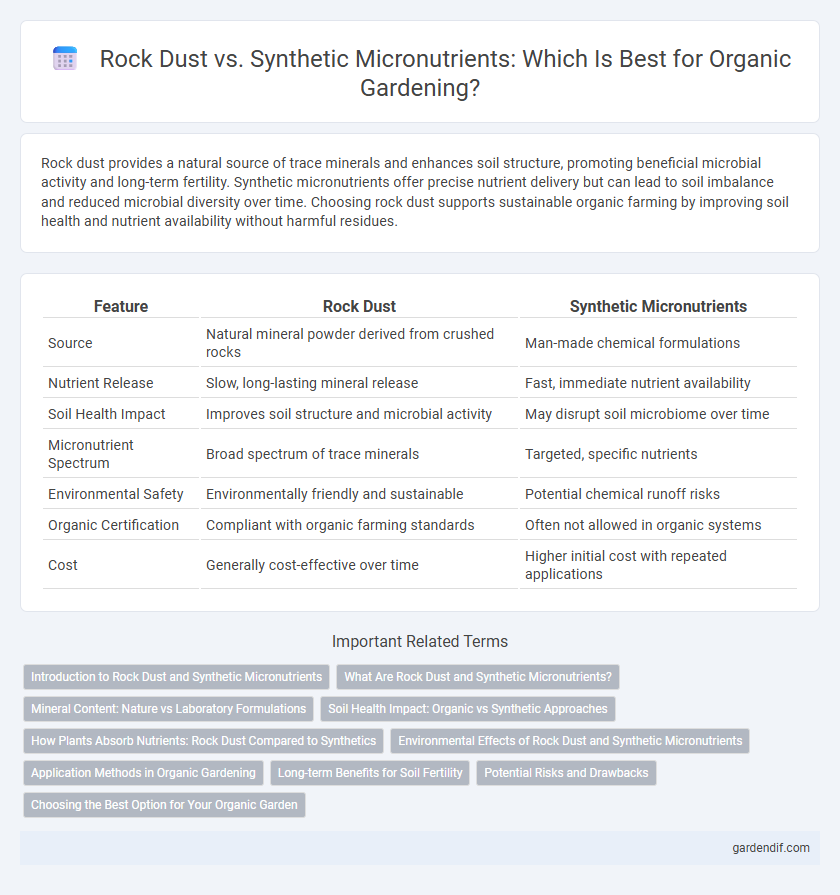
Rock dust vs Synthetic micronutrients Illustration
Rock dust provides a natural source of trace minerals and enhances soil structure, promoting beneficial microbial activity and long-term fertility. Synthetic micronutrients offer precise nutrient delivery but can lead to soil imbalance and reduced microbial diversity over time. Choosing rock dust supports sustainable organic farming by improving soil health and nutrient availability without harmful residues.
Table of Comparison
| Feature | Rock Dust | Synthetic Micronutrients |
|---|---|---|
| Source | Natural mineral powder derived from crushed rocks | Man-made chemical formulations |
| Nutrient Release | Slow, long-lasting mineral release | Fast, immediate nutrient availability |
| Soil Health Impact | Improves soil structure and microbial activity | May disrupt soil microbiome over time |
| Micronutrient Spectrum | Broad spectrum of trace minerals | Targeted, specific nutrients |
| Environmental Safety | Environmentally friendly and sustainable | Potential chemical runoff risks |
| Organic Certification | Compliant with organic farming standards | Often not allowed in organic systems |
| Cost | Generally cost-effective over time | Higher initial cost with repeated applications |
Introduction to Rock Dust and Synthetic Micronutrients
Rock dust is a natural mineral supplement derived from finely crushed volcanic or glacial rocks, offering a broad spectrum of essential trace elements that enhance soil fertility and promote plant health organically. Synthetic micronutrients, manufactured through chemical processes, provide targeted plant nutrients in precise formulations but may lack the diverse mineral complexity found in rock dust. Comparing both, rock dust supports sustainable soil regeneration by replenishing depleted minerals, while synthetic micronutrients deliver immediate nutrient availability for specific deficiencies.
What Are Rock Dust and Synthetic Micronutrients?
Rock dust is a natural mineral product derived from finely ground rocks, rich in essential trace minerals that improve soil fertility and promote plant health by replenishing micronutrients slowly over time. Synthetic micronutrients are chemically manufactured compounds designed to provide specific essential nutrients like iron, zinc, and manganese rapidly and in precise quantities for immediate plant uptake. Both play crucial roles in soil nutrient management, but rock dust offers long-term soil enrichment while synthetic micronutrients deliver targeted, fast-acting nutrient supply.
Mineral Content: Nature vs Laboratory Formulations
Rock dust offers a rich spectrum of naturally occurring minerals and trace elements essential for soil health and plant growth, sourced directly from ground-up volcanic or glacial rocks. Synthetic micronutrients, formulated in laboratories, provide concentrated doses of specific minerals but lack the broad mineral diversity found in natural rock dust. The complex mineral matrix in rock dust enhances soil microbiome activity and nutrient availability, whereas synthetic forms target immediate nutrient deficiencies without contributing to long-term soil ecosystem enrichment.
Soil Health Impact: Organic vs Synthetic Approaches
Rock dust enhances soil health by naturally replenishing essential minerals and improving microbial activity, fostering long-term fertility and structure. Synthetic micronutrients provide quick nutrient availability but often lack the benefits of improving soil organic matter or microbial diversity. Organic approaches with rock dust promote sustainable soil ecosystems, reducing dependency on chemical inputs and enhancing plant resilience.
How Plants Absorb Nutrients: Rock Dust Compared to Synthetics
Plants absorb nutrients from rock dust through a slow mineralization process that releases trace elements like potassium, calcium, and magnesium essential for growth. Synthetic micronutrients dissolve rapidly, providing immediate nutrient availability but often lack secondary minerals critical for long-term soil health. Rock dust enhances microbial activity and soil structure, promoting sustainable nutrient uptake compared to the quick, sometimes imbalanced absorption from synthetic sources.
Environmental Effects of Rock Dust and Synthetic Micronutrients
Rock dust enhances soil health by naturally replenishing trace minerals and improving microbial activity, promoting sustainable agriculture with minimal ecological disruption. Synthetic micronutrients, often derived from chemical processes, can lead to soil toxicity, water contamination, and reduced biodiversity when overused. The environmental benefits of rock dust include carbon sequestration and reduced reliance on chemical fertilizers, contributing to long-term ecosystem resilience.
Application Methods in Organic Gardening
Rock dust application in organic gardening involves top-dressing or soil incorporation to gradually release essential minerals, improving soil structure and microbial activity. Synthetic micronutrients typically require precise foliar sprays or soil drenches to provide immediate nutrient availability, often unsuitable for organic certification. Using rock dust aligns with organic principles by enhancing nutrient cycling naturally and supporting long-term soil health through slow-release mineral supplementation.
Long-term Benefits for Soil Fertility
Rock dust provides essential trace minerals that improve soil structure and promote microbial activity, leading to enhanced nutrient retention and long-term fertility. Synthetic micronutrients offer immediate nutrient availability but may leach quickly and disrupt soil microbial balance over time. Consistent use of rock dust supports sustainable soil health by replenishing vital minerals and fostering natural nutrient cycling.
Potential Risks and Drawbacks
Rock dust, while natural, may introduce heavy metals like lead or arsenic into soil systems, posing long-term contamination risks. Synthetic micronutrients can lead to nutrient imbalances and potential toxicity when over-applied, disrupting soil microbial communities and plant health. Both alternatives require careful management to mitigate adverse environmental and agronomic impacts.
Choosing the Best Option for Your Organic Garden
Rock dust provides a natural source of trace minerals essential for soil fertility, enhancing microbial activity and promoting balanced nutrient uptake in organic gardens. Synthetic micronutrients offer precise nutrient formulations but may disrupt soil health and microbial diversity in the long term. Selecting rock dust aligns with organic principles, supporting sustainable soil regeneration and improved plant resilience.
Rock dust vs Synthetic micronutrients Infographic

 gardendif.com
gardendif.com